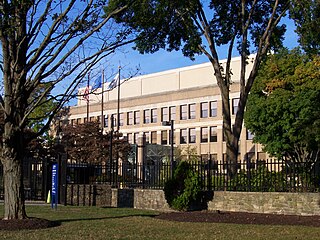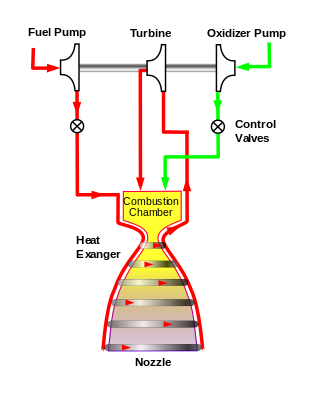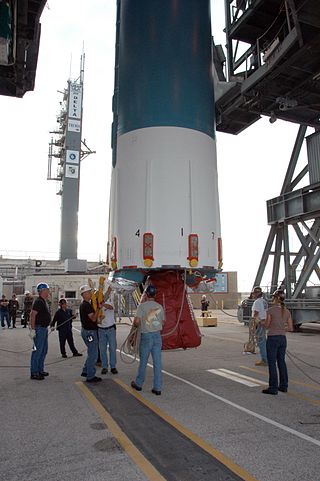
Pratt & Whitney is an American aerospace manufacturer with global service operations. It is a subsidiary of RTX Corporation. Pratt & Whitney's aircraft engines are widely used in both civil aviation and military aviation. Its headquarters are in East Hartford, Connecticut. As one of the "big three" aero-engine manufacturers, it competes with General Electric and Rolls-Royce, although it has also formed joint ventures with both of these companies. In addition to aircraft engines, Pratt & Whitney manufactures gas turbines for industrial and power generation, and marine turbines. In 2017, the company reported that in 2014 they had 38,737 employees supporting more than 11,000 customers in 180 countries around the world. In 2013, Pratt & Whitney's revenue totaled $14.5 billion.

The expander cycle is a power cycle of a bipropellant rocket engine. In this cycle, the fuel is used to cool the engine's combustion chamber, picking up heat and changing phase. The now heated and gaseous fuel then powers the turbine that drives the engine's fuel and oxidizer pumps before being injected into the combustion chamber and burned.

Rocketdyne was an American rocket engine design and production company headquartered in Canoga Park, in the western San Fernando Valley of suburban Los Angeles, in southern California.

The RL10 is a liquid-fuel cryogenic rocket engine built in the United States by Aerojet Rocketdyne that burns cryogenic liquid hydrogen and liquid oxygen propellants. Modern versions produce up to 110 kN (24,729 lbf) of thrust per engine in vacuum. Three RL10 versions are in production for the Centaur upper stage of the Atlas V and the DCSS of the Delta IV. Three more versions are in development for the Exploration Upper Stage of the Space Launch System and the Centaur V of the Vulcan rocket.

Aerojet Rocketdyne Holdings, Inc. is a holding company of Aerojet Rocketdyne, an American manufacturer of rocket, hypersonic, and electric propulsive systems for space, defense, civil and commercial applications. Aerojet traces its origins to the General Tire and Rubber Company established in 1915, while Rocketdyne was created as a division of North American Aviation in 1955.

The Aerojet Rocketdyne RS-68 is a liquid-fuel rocket engine that uses liquid hydrogen (LH2) and liquid oxygen (LOX) as propellants in a gas-generator power cycle. It is the largest hydrogen-fueled rocket engine ever flown.

The staged combustion cycle is a power cycle of a bipropellant rocket engine. In the staged combustion cycle, propellant flows through multiple combustion chambers, and is thus combusted in stages. The main advantage relative to other rocket engine power cycles is high fuel efficiency, measured through specific impulse, while its main disadvantage is engineering complexity.
Aerojet was an American rocket and missile propulsion manufacturer based primarily in Rancho Cordova, California, with divisions in Redmond, Washington, Orange and Gainesville in Virginia, and Camden, Arkansas. Aerojet was owned by GenCorp. In 2013, Aerojet was merged by GenCorp with the former Pratt & Whitney Rocketdyne to form Aerojet Rocketdyne.

The RD-180 is a rocket engine designed and built in Russia. It features a dual combustion chamber, dual-nozzle design and is fueled by a RP-1/LOX mixture. The RD-180 is derived from the RD-170/RD-171 line of rocket engines, which were used in the Soviet Energia launch vehicle and are still in use in the Ukrainian Zenit launch vehicles.

The RS-27A is a liquid-fuel rocket engine developed in 1980s by Rocketdyne for use on the first stage of the Delta II and Delta III launch vehicles. It provides 1.05 meganewtons (240,000 lbf) of thrust burning RP-1 and LOX in a gas-generator cycle. The engine is a modified version of its predecessor, the RS-27; its thrust nozzle has been extended to increase its area ratio from 8:1 to 12:1, which provides greater efficiency at altitude.
The RS-83 was a rocket engine design for a reusable liquid hydrogen/liquid oxygen rocket larger and more powerful than any other. The RS-83 was designed to last 100 missions, and was intended for use on the first stage of a two-stage-to-orbit reusable launch vehicle.

The Space Launch Initiative (SLI) was a NASA and U.S. Department of Defense joint research and technology project to determine the requirements to meet all the nation's hypersonics, space launch and space technology needs. It was also known as the second generation Reusable Launch Vehicle program, after the failure of the first. The program began with the award of RLV study contracts in 2000.
The RL60 was a planned liquid-fuel cryogenic rocket engine designed in the United States by Pratt & Whitney, burning cryogenic liquid hydrogen and liquid oxygen propellants. The engine runs on an expander cycle, running the turbopumps with waste heat absorbed from the main combustion process. This high-efficiency, waste heat based combustion cycle combined with the high-performance liquid hydrogen fuel enables the engine to reach a very high specific impulse of up to 465 seconds in a vacuum. The engine was planned to be a more capable successor to the Aerojet Rocketdyne RL10, providing improved performance and efficiency while maintaining the installation envelope of the RL10.

The Delta Cryogenic Second Stage (DCSS) is a family of cryogenic rocket stages used on the Delta III and Delta IV rockets, and on the Space Launch System Block 1. The stage consists of a cylindrical liquid hydrogen (LH2) tank structurally separated from an oblate spheroid liquid oxygen (LOX) tank. The LH2 tank cylinder carries payload launch loads, while the LOX tank and engine are suspended below within the rocket's inter-stage. The stage is powered by a single Aerojet Rocketdyne-Pratt & Whitney RL10B-2 engine, which features an extendable carbon-carbon nozzle to improve specific impulse.

The RS-88 is a liquid-fueled rocket engine burning ethanol as fuel, and using liquid oxygen (LOX) as the oxidizer. It was designed and built by Rocketdyne, originally for the NASA Bantam System Technology program (1997).
The RS-18 is a reconfigured version of the Rocketdyne Lunar Module Ascent Engine (LMAE), modified to burn liquid oxygen (LOX) and liquid methane (CH4) for NASA's Exploration Systems Architecture Study (ESAS) engine testing in 2008.

Aerojet Rocketdyne is an American manufacturer of rocket, hypersonic, and electric propulsive systems for space, defense, civil and commercial applications. Headquartered in Sacramento, California, the company is owned by Aerojet Rocketdyne Holdings. Aerojet Rocketdyne was formed in 2013 when Aerojet and Pratt & Whitney Rocketdyne were merged, following the latter's acquisition by GenCorp from Pratt & Whitney. On April 27, 2015, the name of the holding company, GenCorp, was changed from GenCorp, Inc. to Aerojet Rocketdyne Holdings, Inc.
The Aerojet Rocketdyne AR1 is a 2,200-kilonewton-class (500,000 lbf) thrust RP-1/LOX oxidizer-rich staged combustion cycle rocket engine project.

Aestus is a hypergolic liquid rocket engine used on an upper stage of Ariane 5 family rockets for the orbital insertion. It features unique design of 132 coaxial injection elements causing swirl mixing of the MMH propellants with nitrogen tetroxide oxidizer. The pressure-fed engine allows for multiple re-ignitions.
The MARC-60, also known as MB-60, MB-XX, and RS-73, is a liquid-fuel cryogenic rocket engine designed as a collaborative effort by Japan's Mitsubishi Heavy Industries and US' Aerojet Rocketdyne. The engine burns cryogenic liquid oxygen and liquid hydrogen in an open expander cycle, driving the turbopumps with waste heat from the main combustion process.














